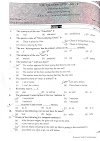Wave and Disturbance
Wave: It is kind of disturbance which is transferred from one part of the medium to the next with finite velocity due to repeated periodic motion of medium particles about their mean position:
Disturbance: it means change in pressure, density or displacement of the particles of the medium about their equilibrium position.
Types of wave
• These waves require a material medium for their propagation.
• These waves transfer energy and momentum through the limited motion of the particles with the medium remaining at its own place.
• For the propagation of mechanical waves, it is essential that the medium must posse’s elasticity, inertia and low resistance for motion [i.e., damping must be very small]
E.g., water waves, sound waves, waves in a spring or a stretched string, waves in organ pipe, in sonometer, tuning fork, etc.
Mechanical wave is two types:
i. Transverse wave:
• Vibration is perpendicular to the propagation of wave. It is also known as lateral wave.
• Particles execute S.H.M. about the mean position.
• Medium must be rigid. So, these waves are present in solid but absent gases.
• Pressure and density remain uniform.
• Polarization is possible.
• Only energy is transferred but not mass and momentum.
ii. Longitudinal / axial wave:
• Vibration is parallel to the propagation wave.
• Cannot be polarized.
• Energy, mass and momentum all are transferred.
• Density is not uniform.
• Present in solid, liquid and gases.
• These waves do not require any medium for their propagation.
• Light waves, heat radiation (infrared rays), γ – rays, X – rays, microwaves, etc. are examples of electromagnetic waves.
Particle and Wave Velocity
Particle velocity
Wave velocity
Vibrations
Free vibration: when a body vibrates without the help of any external force, it’s without the help of any external force, its vibrations are known as free vibration. The frequency of the free vibrations is called natural frequency of the body.
Forced or driven vibrations: when a body is made to vibrate with help of an external force, its vibrations are said to be forced vibrations. Examples: sonometer wire, resonance tube.
Resonance: If a body is made to vibrate by some external force and the natural frequency of body is equal to that of vibrator, the body vibrates with maximum amplitude and intensity of sound becomes maximum. This phenomenon is known as resonance. It is special type of forced vibration.
Undamped vibrations: When force of friction on a vibrating body is zero, there will be no dissipation of energy of the body. Hence amplitude (a) of energy of the body will remain constant.
Damped vibrations: Practically friction cannot be zero. Hence, energy of vibration dissipates. Therefore, amplitude of vibration of body goes on decreasing. Such vibrations are called damped vibrations.
Transverse wave equation and Velocity
Equation of transverse wave when wave travels towards positive x-axis is:
Equation of transverse wave when wave travels towards negative x-axis is:
Velocity of sound in Gases
In general, velocity of sound in solid, liquid and gases are given as
According to Newton, propagation of sound wave in gas is isothermal. And, velocity of sound in gas
According to Laplace, propagation of sound wave in gas is adiabatic. And, velocity of sound in gas
Here, P is pressure and is atomicity.
Note: At NTP, velocity of sound in air resulted from Newton's and Laplace correction are 280m/s and 332m/s respectively.
Factors affecting the velocity of sound in a gas
Temperature:
(As, for 1-mole gas, PV = RT)
Thus,
Density:
At same pressure,
Pressure:
For a gas, , R, T and M are constant,
So, (independent of pressure)
Moisture (or Humidity): Humdidity
Frequency and wavelength: Independent









0 Comments